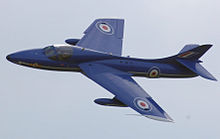Leading-edge extension
This article needs additional citations for verification. (December 2007) |
A leading-edge extension is a small extension to an aircraft wing surface, forward of the leading edge. Different kinds of extensions have been used for different reasons.
Leading-edge slat
A Leading edge slat is an aerodynamic surface running spanwise just ahead of the wing leading edge. When deployed it creates a leading edge slot between the slat and wing which directs air over the wing surface, helping to maintain smooth airflow at high angles of attack. This delays the stall, allowing the aircraft to fly at lower speeds. Slats may be made fixed, or retractable in normal flight to minimize drag.
Dogtooth extension

A dogtooth is a small, sharp zig-zag break in the leading edge of a wing. It is usually used on a swept wing, but also on straight wings ("Drooped Leading Edge" arrangement), to generate a vortex flow field to prevent separated flow from progressing outboard at high angle of attack.[1] The effect is the same as a wing fence.[2]
Where the dogtooth is added as an afterthought, as for example with the Hawker Hunter and some variants of the Quest Kodiak, the dogtooth is created by adding an extension to the outer section only of the leading edge.
Leading-edge cuff
A Leading edge cuff (or wing cuff) is a fixed aerodynamic device employed on fixed-wing aircraft to introduce a sharp discontinuity in the leading edge of the wing, with the same purpose as a dogtooth, but with usually a slightly drooped outboard leading edge extension.
Leading-edge kink

The Avro Vulcan prototypes had a delta wing with a straight leading edge. To cure handling problems, a shallow triangular extension was added to the outer leading edge, giving the planform of a compound delta having three leading edge sections at different angles, with kinks between the sections.
Later models of the English Electric Lightning had the wing tip extended forwards to create a leading edge kink at approximately two-thirds span.
Leading-edge root extension

A leading-edge root extension (LERX) is a small fillet, typically roughly triangular in shape, running forward from the leading edge of the wing root to a point along the fuselage. These are often called simply leading-edge extensions (LEX), although they are not the only kind. To avoid ambiguity, this article uses the term LERX.
On a modern fighter aircraft LERX provide usable airflow over the wing at high angles of attack, so delaying the stall and consequent loss of lift. In cruising flight the effect of the LERX is minimal. However at high angles of attack, as often encountered in a dog fight or during takeoff and landing, the LERX generates a high-speed vortex that attaches to the top of the wing. The vortex action maintains a smooth airflow over the wing surface well past the normal stall point at which the airflow would otherwise break up, thus sustaining lift at very high angles.
LERX were first used on the Northrop F-5 "Freedom fighter" which flew in 1959,[3] and have since become commonplace on many combat aircraft. The F/A-18 Hornet has especially large examples, as does the Sukhoi Su-27. The Su-27 LERX help to make some advanced maneuvers possible, such as the Pugachev's Cobra, the Cobra Turn and the Kulbit.
Aircraft using LERX
A few examples of aircraft with leading edge root extensions are listed below.
- China
- China/Pakistan
- Iran
- Russia/USSR
- Sukhoi Su-27 and derivatives, including the Sukhoi Su-34 and the Sukhoi Su-47.
- Mikoyan MiG-29
- Sukhoi PAK FA – on PAK-FA aircraft the part of the wing that includes the LERX is movable to control the airflow at high angles of attack, similar to a wing leading flap. – LEVCON (this is "active" control surface)
- Yak-130
- USA/UK
- F-5 Freedom Fighter
- F-16 Fighting Falcon and its unsuccessful competitor the YF-17 Cobra
- F/A-18 Hornet/Super Hornet
- AV-8 Harrier II/RAF Harrier II
Chine


The long sideways extensions of a forward fuselage are usually called chines or sometimes strakes where they are separate surfaces not blended into the fuselage. Chined fuselages can form significant (lifting) aerodynamic surfaces in their own right, such as on the Lockheed Blackbird.
See also
References
- ^ Effects of Wing-Leading-Edge Modifications on a Full-Scale, Low-Wing General Aviation Airplane, Nasa TP 2011
- ^ A Two-seat Gnat Development for the R.A.F. Flight 1959
- ^ Green, W. and Swanborough, G.; The complete book of fighters, Salamander, 1994
